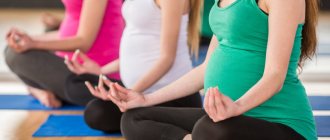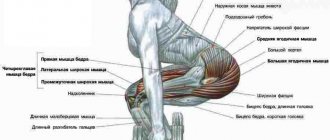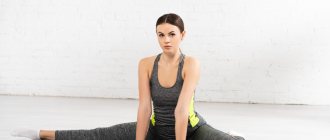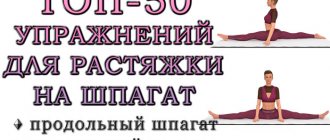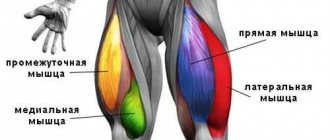Flexibility is one of the important elements of healthy physical condition. And if previously visitors to fitness clubs paid practically no attention to the development of flexibility, today it is even more than necessary. The ultimate goal of any exercise program should be to improve natural abilities, not a race to the bottom.
Before setting a goal for yourself - whether it be the desire to do the splits, run a marathon or swim across the Bosphorus - you must adequately assess your level of training, age and state of health. Remember: any physical activity should be beneficial, not harmful.
The exercises used to compile this complex emphasize the fact that you must have sufficient flexibility already at the initial stage. After all, any stretching exercise, or rather its correct implementation, involves only a slight deviation from the usual indicators.
This means that you have to do long and painstaking work with your body. And here one or two lessons will not be enough for success.
This selection of exercises is an active complex involving not only the muscles of the inner thigh. There are also exercises for other muscle groups that are in direct connection with the muscles involved in the splits.
The order of performing a set of exercises for splits
For many, splits have become a dream and even a goal. This aspiration is laudable, especially if you regard it as a challenge to yourself and the capabilities of your body. But before you begin to implement your plan, evaluate the natural capabilities of your body. Remember that not everyone has a hip joint that allows them to do a cross split. In this case, you should only try longitudinal twine.
This set of exercises is aimed at working out those muscle groups of the body, the correct work of which, flexibility and elasticity, will allow you to get closer to your goal. Start small, build up gradually. Hold the stretch for no more than 15 seconds, gradually increasing the time to 30 seconds. Longer stretching does not make sense and may even be harmful.
Work in a warm room, with warm muscles. Do not stretch if you are sick, have recently been injured, or feel pain and discomfort that only intensifies during exercise.
Consider your body's capabilities! Don't hurt yourself.
Execution time: 10-15 minutes
Will I be able to?
Very often in advertisements of various fitness clubs you can find loud slogans like “Splits in 1 month!” You don't need to set yourself a time frame.
The human body is individual. For some, three weeks is enough to do the splits, while others will do it only after a year. Moreover, this does not depend on age and complexion. Every person has a certain degree of flexibility. This is genetically determined.
There are no people who cannot stretch. But the degree of stretching and the time it takes are very different.
Stretching the muscles that adduct and abduct the leg at the hip joint while lying on your back
- Starting position: lying on your back, hands pressed tightly to the floor.
- Raise both legs perpendicular to the floor, pointing your toes away from you. Try to carefully spread your legs to the sides without lifting your lower back, arms and head from the floor.
- Start with a small amplitude of movement, gradually increasing it and the tempo of movement slightly. Repeat the exercise 10-20 times.
IMPORTANT
- The adductor muscle group is often a poorly developed group.
- Insufficient development of the adductor muscle group can be the cause of weakness of the pelvic floor muscles.
- Work carefully so as not to harm yourself.
- Press your lower back well into the floor.
- The exercise is contraindicated for sprained inguinal ligaments.
WHAT WE ARE DEVELOPING
- hips,
- back.
FOR WHAT
- lengthening of the adductor muscles of the thigh,
- strengthening the hip joints,
- increased flexibility.
PREVENTION
- discomfort in the perineal area,
- injuries in dynamic sports.
WHAT WORKS
- thigh muscles (pectineus, adductor longus, gracilis, adductor magnus, sartorius),
- calf muscles (medial head of the gastrocnemius muscle, soleus),
- gluteus maximus muscle,
- back muscles (erector spinae, latissimus).
COACH ADVICE
As you become more confident in yourself and your body, you can help yourself stretch slightly with your hands, placing them on the inside of your knee. Pressure with force no more than 10-15%.
How is longitudinal twine useful and for whom is it contraindicated?
Benefits of longitudinal twine:
- improves mobility of the hip joints and sacrum;
- normalizes blood flow in the pelvis;
- improves the elasticity of the inguinal ligaments
- straightens the spine, aligns posture;
- prevents pathologies of the genitourinary system (according to experts, as it prevents congestion);
- is an excellent workout for the muscles of the inner thigh.
Movement is contraindicated when:
- hyperthermia;
- chronic joint diseases;
- recent fracture or injury;
- acute inflammations.
If you experience a buzzing in your ears or feel dizzy during exercise, you need to stop training. The best thing to do in this case is to lie down, relax, and drink plain water without gas. If such symptoms recur repeatedly, it is recommended to go to the hospital. Most likely, there are problems with the cardiovascular system.
Stretching the rotator cuff muscles while lying on your back
- Starting position: lying on your back, legs together, arms spread to the sides, palms up.
- As you exhale, bend your right leg at the knee and turn it towards your left. In this case, the shoulders lie on the floor, twisting occurs from the lumbar spine. Stay in this position for 10-15 seconds. Return to the starting position and repeat the same with your left leg.
- Do 10-20 repetitions on each leg.
WHAT WORKS
- multifidus muscles,
- rotator cuff muscles,
- oblique abdominal muscles,
- gluteal muscles,
- tensor fascia lata,
- sartorius.
WHAT WE ARE DEVELOPING
- rotator cuff muscles,
- spine.
FOR WHAT
- stabilization of the body in space,
- development of correct stride pattern.
PREVENTION
- injuries in sports,
- tension in the lumbar spine,
- pelvic instability.
COACH ADVICE
When performing this exercise, do not lean to the side. Try to press your shoulder blades as close to the floor as possible while twisting. Work only from the lower back.
IMPORTANT
- Consider your body's capabilities.
- Engage antagonist muscles.
- Do not perform the exercise if you have hernias or protrusions in the lumbar spine.
At the start, attention!
There are three types of people: lucky ones with natural flexibility, those who stretch from an early age (gymnasts, ballerinas), and, finally, “wooden comrades”. But the latter can also be stretched. The main thing is to do it correctly. And warming up before stretching will help here.
Step one . Choose suitable music. Ideally, this should be a mix: an invigorating beginning for an intense warm-up and calmer motives for the main part. If desired, you can find special fitness accessories that are well suited for stretching.
Select several dynamic and smooth compositions for the first and second parts of the warm-up, or use a ready-made fitness mix.
Step two . A good warm up before stretching. The following complex is suitable here: running with high hips, leg sweeps, jumping (with or without a jump rope), plie squats (with wide legs), leg swings.
We actively warm up the leg muscles before stretching. Running, squats, leg swings.
Step three . A calmer complex is “smooth charging”. This includes all kinds of lunges, bending the body towards the legs (sitting and standing) and twisting.
After warming up, we perform a stretching routine. Longitudinal and transverse lunges, bends and other exercises.
Stretching the knee extensor and abdominal muscles while kneeling
- Starting position: standing on four points of support (palms - knees), lift your hands off the floor and carefully, slowly bend back, always resting your hands on your ankles or heels.
- In this position, lift your pelvis up, arch your back and pull your shoulders back. There should be no discomfort or pain in the knee and ankle when performing this exercise.
- Hold this position and carefully return to the starting position. Repeat the exercise 10 times.
IMPORTANT
- Your knees should be on something soft.
- Do not perform the exercise if you have bad knees or problems in the lumbar spine.
- The task is not to bend in the lower back, but to push the pelvis upward.
- Hold the stretch for no more than 15 seconds. Then it’s better to pause and repeat again.
WHAT WE ARE DEVELOPING
- body flexor muscles,
- knee and ankle.
FOR WHAT
- strengthening pelvic stability,
- development of pelvic mobility,
- stretching the muscles of the front line.
COACH ADVICE
The exercise is not the easiest, so at first, when leaning back, you can use a higher support (chair, sofa, bench) instead of your ankles.
PREVENTION
- pelvic tilt,
- turning off the abdominal muscles from work,
- stoop,
- problems with the pelvic organs.
WHAT WORKS
- muscles of the thigh and buttocks (vastus medialis, intermedius and lateralis, superior and middle sartorius, rectus, tensor fasciae lata, pectineus, gluteus medius),
- deep pelvic muscles (lumbar major, iliacus).
Hamstring stretch while lying on your back
- Starting position: lying on your back, lift your head and shoulder blades from the floor.
- Lift one straight leg up and grab it with both hands at the ankle or above the knee (but the leg should remain straight). The second leg lies on the floor.
- Without bending your knee, begin to pull your straight leg towards you in small jerks. Change your leg. Do 10-20 repetitions on each leg, gradually increasing the tempo and range of movement.
COACH ADVICE
Make sure that your pelvis does not come off the floor at the moment when you pull your leg towards you!
IMPORTANT
- Keep your knee straight.
- Do not lift your pelvis and chest off the floor.
- Maintain a neutral arch in your lower back.
WHAT WE ARE DEVELOPING
- hips,
- lower back.
FOR WHAT
- pelvic stabilization,
- strengthening the knees,
- increased flexibility of the hamstrings.
PREVENTION
- leg injuries,
- instability of the hip and knee joints,
- lower back pain.
WHAT WORKS
- semimembranosus muscle,
- semitendinosus muscle,
- biceps femoris muscle,
- gluteus maximus muscle,
- iliopsoas muscle,
- rectus femoris muscle,
- tensor fascia lata,
- pectineus muscle,
- calf muscle,
- soleus muscle.
Stretching the hip extensor muscles while lying on your back
- Starting position: lying on your back, natural arch in the lower back.
- Bend your right leg at the knee and bring it towards your chest. Without lifting your left leg from the floor, grab your right leg with both hands under the knee on the outside and pull it towards your chest.
- Repeat the exercise for the other leg. Do 10-20 repetitions on each leg, gradually increasing the tempo and range of movement.
TRAINER'S TIPS
- Try to pull your knee toward your chest without straining your neck muscles. Pull the opposite leg away from you with your toe.
- Pull your knee closer to your chest.
- Keep the other leg as straight as possible at the knee.
WHAT WORKS
- gluteal muscles,
- back muscles (erector spinae, lower latissimus dorsi muscle),
- thigh muscles (semitendinosus, biceps femoris).
WHAT WE ARE DEVELOPING
- buttocks,
- back.
FOR WHAT
- warming up the buttock muscles before training,
- coordination of the abdominal muscles and lower back muscles,
- activation of the erector spinae muscle.
PREVENTION
- pain in the lumbar spine,
- pelvic instability.
When to practice?
Here experts disagree. Many people believe that it is better to do split stretching exercises in the morning, because it is more difficult and means the muscles will remember the load longer.
But in the morning the pain is stronger due to the fact that the body has only recently woken up. It's easier to stretch in the evenings. But this needs to be done more often. For example, you either exercise 3-4 times a week in the morning and endure pain, or stretch 5-7 times in the evening.
You can try both options and understand which one is convenient for you in terms of sensations and free time that can be allocated for training.
Doing reverse crunches correctly - technique, subtleties, secrets and rules for performing the exercise (105 photos)Doing wide squats: technique of performing the exercise and correct positioning of the legs. 120 photos and videos of the main types of squats
Exercises in the gym - tips for choosing the best set of exercises. Recommendations for beginners and tips on how to practice correctly (85 photos)
And now stretching exercises for splits for beginners and more!
Stretching the adductor muscles in a side lunge position
- Starting position: standing straight, legs wide enough.
- Shift your body weight to your right leg, bend it at the knee and at the same time turn the toe of your left leg towards your right. The left leg remains straight. Lower yourself and touch the floor with your left hand if possible.
- Repeat the same on your left leg. Do 10-20 repetitions on each leg.
TRAINER'S TIPS
- Over time, try to sit in this position on your leg bent at the knee, lowering your pelvis down to the floor as much as possible.
- The feet are “glued” to the floor.
- Approach the exercise carefully, consider how the muscles are attached and where the fibers are directed. Please note that some of them have attachment points in the front in the pelvis area and in the back on the bone (gracilis muscle, for example).
- Gradually increase the amplitude.
- Do not work through pain or if there is an injury in the pelvic area. Don't hurt yourself.
WHAT WE ARE DEVELOPING
- thighs and legs,
- pelvis
FOR WHAT
- stretching of the inner thigh muscles,
- strengthening the muscles of the pelvis and pelvic floor,
- knee stabilization.
PREVENTION
- problems with the pelvic organs,
- weakness of the adductor muscle group of the thigh,
- instability of the foot and knee.
